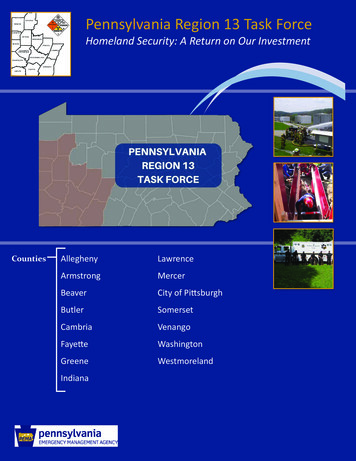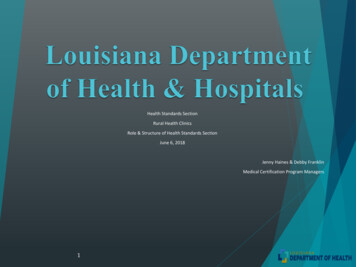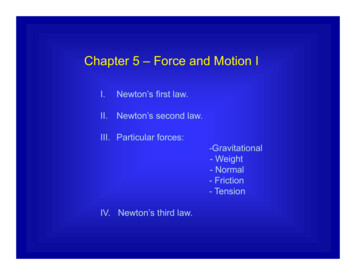
Transcription
Pennsylvania Region 13 Task ForceHomeland Security: A Return on Our BeaverCity of ngtonGreeneWestmorelandIndiana
State-Level CoordinationPROTECTING PENNSYLVANIANo one can do it alone. In Pennsylvania, multiple jurisdictions, agencies, and disciplines work together to strengthen ourability to prevent, protect against, mitigate, respond to, and recover from acts of terrorism and other catastrophic events.Pennsylvania Criminal Intelligence Center (PaCIC) is managed by the Pennsylvania State Police and is the primaryTxt about something here.all-hazards fusion center comprised of analysts and subject matter experts from local, state, and federal agencies. In2016, PaCIC fulfilled almost 40,000 requests for information and developed 57,434 products including briefs and alertsranging from dirty bombs and the increased findings of Carfentanil in heroin, to attacks on natural gas facilities. In 2016,PaCIC completed 43 event assessments for emergency response, public sector and private sector partners.Critical PartnersIncreased Demand, Decreased FundingHomeland Security Grant Program Funding (HSGP)The private sector owns and operateshas dropped 48% since 2010. However, demand foran estimated 85% of infrastructureservices continues to increase. For example, inand resources that are critical to our2016, PaCIC received 993 reported cyberphysical and economic security.compromises, an increase of over 400 since 2015. 58M 31MYear: 2010Year: 2016HSGP and UASI fundsawarded to PAGOHS has mapped over 30,000 sitesin PA.How HSGP Funds Supports Agribusiness and Food Safety: Lab systems and equipment which are critical to the safety of PA’sfood supply and agriculture systems. Food safety communications and inspection system forapproximately 130 local and state agency health jurisdictions with foodsafety responsibilities. Equipment to enhance lab testing for real-world food contaminationincidents.Duke Energy's gas-powered plant,Masontown, Pennsylvania. PA is positioned to lessen the devastating effects of a disease outbreakon PA’s poultry industry through mapping and database investment.The Governor’s Office of Homeland Security (GOHS) helps to secure Pennsylvania from acts of terrorism and reduce thevulnerability of PA’s critical infrastructure. GOHS provides training, exercises, and learning opportunities not otherwiseavailable to participants. Since 2012, GOHS has provided more than 30 training courses to over 4000 public and privatepartners, 28 tabletop prevention and protection exercises, and engaged over 7500 participants with 29 seminars.The Pennsylvania Emergency Management Agency (PEMA) is the lead agency forthe annual Threat and Hazard Identification and Risk Assessment (THIRA) and StatePreparedness Report (SPR). The result is a comprehensive strategy for fundingcapability gaps at state and regional levels.PEMA maintains deployable assets purchased using HSGP funds to support countiesduring disasters; such assets include trailer-mounted generators, bathroom showertrailers, light tower trailers, non-potable water trailers, and remotely operatedcamera trailers.
Regional CoordinationVital StatisticsThe Regional Task Force is a model forPENNSYLVANIA REGION 13: A SHARED RESPONSIBILITYintergovernmental and multi-jurisdictionalThe Pennsylvania Region 13 Task Force hascooperation.a history of coordinated planning and Population: Over 3 Millionprotection that started as the Urban Area Area: 10,233 Square MilesWorking Group in the 1990s. After the Municipalities: 737events of 9/11, leaders in the region Fire Departments: 734recognized the strength in organizing and Police Departments: 399 Emergency Med Service Agencies: 210 Hospitals: 67working together. The PittsburghUrban Areas Security Initiative (UASI)uses HSGP funding to supportHigh capacity pump drains acontaminated reservoir in IndianaCounty.counter-terrorism, critical infrastructure,and weapons of mass destruction response capabilities. There are noCapabilitiesindividual county or city projects approved. All projects are regional.The PA Region 13 Task Force has thefollowing capabilities:DEPTH OF CAPABILITIES Hazmat Teams: 15The Region 13 Task Force provides great depth in capabilities and is Bomb Disposal Teams: 2supported with Homeland Security funds: Explosive Detection K9 Teams: 16 Law Enforcement— Training and equipment for Tactical Teams Water Response Teams: 27 Urban Search and Rescue(SWAT), Explosive Ordnance Disposal, K9 Detection Teams. Western All Hazards Fusion Center Regional Communication Ntwk (ESInet) Western Area All Hazards Fusion Center— Specialized terrorism and Regional 9-1-1cyber intelligence gathering to protect critical infrastructure such as Tactical (SWAT) Teamsthe Beaver Valley Nuclear Power Station, Marcellus Shale wells, andwater treatment plants. Fire and Hazardous Materials—Equipment and training for someInvestmentregional fire and hazmat activities. Water Response and Safety—Equipment, planning and training forPlanningTrainingEquipment25%40%Maintenancewater response teams within the region. Incident Management Team—Equipment and training to support30%coordinated statewide disasters. Health and Medical—Training, exercises and equipment for firstresponders. Communications—Regional Communications Network connects allcounties in the region for coordination during response usinginteroperable voice and data communications as well as 9-1-1 traffic.
ALL-HAZARDS REGIONAL FUSION CENTER AND HOMELAND PROTECTIONThe Task Force Law Enforcement Committee oversees the Western Pennsylvania AllHazards Fusion Center (WPAHFC). The WPAHFC is co-located with the FBI and has fulltime resources assigned by the Pennsylvania State Police and the Pittsburgh Police.Homeland Security funds are used to support critical infrastructure protection plannersand intelligence analysists including salaries, training, and specialized officeequipment.A weekly intelligence product is produced and disseminated to all partners. Specialintelligence products are produced as needed. Fusion Center personnel work closelywith Department of Homeland Security personnel to conduct risk assessments andprovide 3D digital mapping to critical infrastructure throughout the region, all of whichis made possible through support provided by the HSGP.Significant Activity ReportedBomb Squad ResponseBomb ThreatPolice Special ResponseHazardous Materials IncidentSpecial Event*Natural HazardTotalTotal263450651984278In one five-month timespan, the Task Force tracked andresponded to almost 300 significant events in the region,a capability made possible by funding from the HSGP.*Planned event requiring special resources deployment“The bomb squad determined there were contents that resembled an explosive, and the area wasevacuated The competition resumed after the bomb squad used a robot to disable the device andthe area was cleared ”The Task Force supports local tactical teams with trainingincluding 7 different courses during the first two quarters of2017. Explosive ordnance disposal teams are equipped withEOD suits, multiple types and sizes of robots and accessories,and training materials. Two EOD teams (Pittsburgh andAllegheny County) respond to incidents in all jurisdictions withinthe region. The region’s local SWAT and tactical teams areequipped with body armor, radios, headsets, radio accessories,tactical ladders, and optics including robots. Skills are honedthrough specialized training. These trainings include, but are notlimited to, FBI Hazardous Device School and Advance OrdnanceRecognition.
HAZARDOUS MATERIALSThe Fire and Hazardous Materials Committee coordinates regional fire and hazmat activities, which includes providingstate-of-the-art detection equipment, personal protective equipment, and foam trailers. The Task Force currently has anequipment life-cycle plan in place for high end detection replacement, and the HSGP grant funding to support detectiondevices with maintenance contracts for repair, replacement, and calibration.According to Southwest Fusion Center analysts, four meth lab incidents in the region were reported in 2017. Meth labincidents can be complex responses due to the cause of the discovery of the lab, and can involve decontaminating theindividuals possibly exposed, handling extremely hazardous substances, and mitigating contaminated locations.Explosion at the Suspected Meth Lab in ConnellsvilleSource: Action News, Trib LiveOn May 21, firefighters responded to a call regarding anexplosion at a duplex in Connellsville. The blast blew out awindow in the house and injured three people. TheConnellsville police observed several items in the home thatindicated that the explosion was related to a suspectedmeth manufacturing operating inside the home. The FayetteCounty Hazmat team responded as well.CommunicationsCommunications is the backbone of the Task Force. The Communications and Technology Committee oversees theprocurement of radios, accessories, command posts with satellite uplinks, and emergency operations center technologyupgrades. The most important project to be implemented under the Communications and Technology Committee is theEmergency Services Internet Protocol Network (ESInet). This communications network links every county and the City ofPittsburgh, and allows the region to share 9-1-1 system resources, resulting in operational efficiencies and costsavings. The counties within the Task Force currently share a 9-1-1 phone system and other applications. Some countieswithin the region are beginning to share computer aided dispatch systems using ESInet.Health and MedicalHealth and Medical capabilities are supported through the HSGP. This support includes training and exercises related toMass Prophylaxis, training and exercises supporting EMS Strike Teams which provide overflow capabilities for hospitals,the procurement and maintenance of a regional pharmaceutical cache for responders and their families, and the procurement and maintenance of mobile oxygen modules for use in a mobile hospital setting.
INVESTMENT ENABLES COUNTY AND REGIONAL CAPABILITIESThe 16 Explosive Detection K9 Teams respond within the region on a regular basis.They have been deployed to a Major League Baseball All-Star Game, the G20Summit, and the Papal visit to Philadelphia. On the same day, they may respondto various bomb threats or monitor visits to the area by dignitaries.The Task Force currently has 27 water response teams. These teams deploythroughout the region and state. During Hurricane Sandy, Tropical Storm Lee and Tropical Storm Irene, the Task Forcedeployed numerous water response teams to the eastern side of the state.Incident Management Teams are essential for management of,and response to, local, regional, and national emergencies. HSGPfunds are used to properly train and equip the Task Force IMT.Equipment needed includes tents, generators, personalprotection, position ID vests, hand tools, and office supplies andequipment.The Search, Collapse, and Trench Rescue Teams are supportedthrough trainings and exercises on a regional basis. HSGP fundssupport critical equipment purchase and maintenance, includingshoring systems, electric tools, high end listening devices forvictim location, and collapse rescue trailers.Bomb robot inspects a suspicious device in Pittsburgh.The Urban Search and Rescue (USAR) Team was recently deployed to a flooding incident near one of the dams south ofPittsburgh. A church in the Connellsville area was damaged as a result of the flooding. The USAR Team assessed thedamage, shored up the building, and prevented loss of property and a danger to the community. Equipment andtraining were supported by HSGP funds.EQUIPPED, TRAINED, READYIt is not enough to just have equipment and training.The Region 13 Task Force USAR Team (PA Strike Team 1) is a highlyskilled resource and ready to deploy for even the most complicated missions. In July2017, a three-story brick building in Washington, PA collapsed, trapping a womanbeneath two floors of rubble and thousands of pounds of debris. The complex rescuerequired the Strike Team to install emergency shoring to stabilize the building andprevent secondary collapse. In order to reach the victim, they breached the wall of anadjacent building, and then provided advanced medical care to the patient to combatcrush syndrome. USAR team members and responders painstakingly removed debris andcarefully lifted portions of rubble during the process. After 9 hours, they were able tosafely extricate the patient without causing further collapse or danger to therescuers. The HSGP supports the capabilities, skilled training, and operational readinessof the Task Force.Nate Guidry/Pittsburgh Post-Gazette
The 16 Explosive Detection K9 Teams respond within the region on a regular basis. They have been deployed to a Major League aseball All-Star Game . Equipment needed includes tents, generators, personal protection, position ID vests, hand tools, and office supplies and equipment. The S










